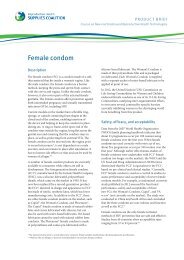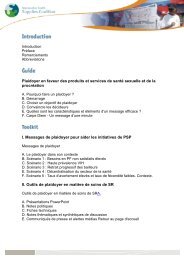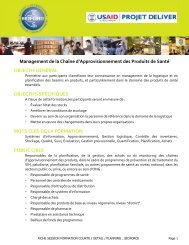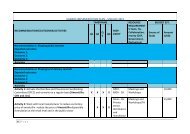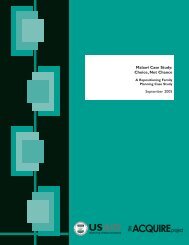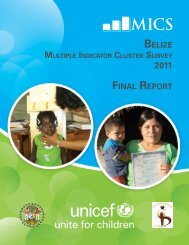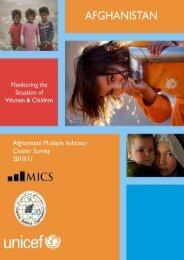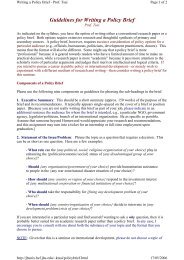Frequently Asked Questions on the Prequalification of Medicines for ...
Frequently Asked Questions on the Prequalification of Medicines for ...
Frequently Asked Questions on the Prequalification of Medicines for ...
You also want an ePaper? Increase the reach of your titles
YUMPU automatically turns print PDFs into web optimized ePapers that Google loves.
© World Health Organizati<strong>on</strong>, 2011<br />
This document was funded under an Agreement <strong>for</strong> Per<strong>for</strong>mance <strong>of</strong> Work,<br />
SPHQ11-APW-802, with <strong>the</strong> World Health Organizati<strong>on</strong>, Geneva, Switzerland.<br />
All rights are reserved by <strong>the</strong> World Health Organizati<strong>on</strong>. This document may be<br />
reviewed, abstracted, reproduced and translated, in part or whole, <strong>on</strong> c<strong>on</strong>diti<strong>on</strong><br />
that <strong>the</strong> World Health Organizati<strong>on</strong> is in<strong>for</strong>med and fully acknowledged. Any<br />
reproducti<strong>on</strong> must not be sold or used <strong>for</strong> commercial purposes.
Quality <strong>of</strong> Reproductive Health <strong>Medicines</strong><br />
<str<strong>on</strong>g>Frequently</str<strong>on</strong>g> asked questi<strong>on</strong>s<br />
<strong>on</strong> <strong>the</strong> prequalificati<strong>on</strong> <strong>of</strong><br />
medicines <strong>for</strong><br />
reproductive health<br />
C<strong>on</strong>cept Foundati<strong>on</strong><br />
Bangkok, Thailand and Geneva, Switzerland<br />
April 2011
Table <strong>of</strong> c<strong>on</strong>tents<br />
Introducti<strong>on</strong> 3<br />
1. What are <strong>the</strong> benefits in getting our products prequalified by WHO? 4<br />
2. How do we apply <strong>for</strong> prequalificati<strong>on</strong>? 6<br />
3. Will we need to make any changes be<strong>for</strong>e we can get<br />
a product prequalified? 6<br />
4. Does our API manufacturer need to have its API prequalified? 7<br />
5. What is <strong>the</strong> situati<strong>on</strong> regarding excipients? 8<br />
6. What are <strong>the</strong> manufacturing batch size requirements <strong>for</strong> process<br />
validati<strong>on</strong> and stability study data? 9<br />
7. Can we submit annual product quality review data <strong>for</strong> batches<br />
manufactured in <strong>the</strong> past instead <strong>of</strong> recent validati<strong>on</strong> data? 9<br />
8. Does our horm<strong>on</strong>al c<strong>on</strong>traceptive producti<strong>on</strong> line need to be<br />
in a separate building? 10<br />
9. If we obtain prequalificati<strong>on</strong> <strong>of</strong> <strong>on</strong>e <strong>of</strong> our products, does that<br />
apply to all products and all our producti<strong>on</strong> sites? 11<br />
10. Since our products are generics, will we be required to<br />
undertake bioequivalence studies? 11<br />
10.1 How should a bioequivalence study be designed? Is <strong>the</strong>re<br />
a comm<strong>on</strong> protocol? How many subjects are required? 12<br />
10.2 Are <strong>the</strong>re approved CROs that must be used? 14<br />
10.3 What additi<strong>on</strong>al requirements are <strong>the</strong>re <strong>for</strong> <strong>the</strong> placebos<br />
and would placebo tablets c<strong>on</strong>taining ei<strong>the</strong>r lactose or<br />
ferrous fumarate be treated differently? 15<br />
10.4 What do we do if <strong>the</strong> approved comparator product is<br />
not available in our country? 16
Introducti<strong>on</strong><br />
The United Nati<strong>on</strong>s Prequalificati<strong>on</strong><br />
Programme <strong>for</strong> quality medicines<br />
is managed by <strong>the</strong> World Health<br />
Organizati<strong>on</strong> (WHO). It issued its<br />
first Expressi<strong>on</strong> <strong>of</strong> Interest <strong>for</strong> medicines<br />
<strong>for</strong> reproductive health in<br />
October 2006. Since <strong>the</strong>n it has expanded<br />
its scope and following its<br />
most recent Expressi<strong>on</strong> <strong>of</strong> Interest<br />
(May 2010) will accept requests <strong>for</strong><br />
prequalificati<strong>on</strong> <strong>of</strong> <strong>the</strong> following<br />
products:<br />
1. Oral horm<strong>on</strong>al c<strong>on</strong>traceptives<br />
ethinylestradiol + desogestrel,<br />
tablet 30 micrograms +150<br />
micrograms<br />
ethinylestradiol +<br />
lev<strong>on</strong>orgestrel, tablet<br />
30 micrograms + 150<br />
micrograms<br />
lev<strong>on</strong>orgestrel, tablet 30<br />
micrograms<br />
lev<strong>on</strong>orgestrel, tablet 750<br />
micrograms (pack <strong>of</strong> two); 1.5<br />
mg (pack <strong>of</strong> <strong>on</strong>e)<br />
norethister<strong>on</strong>e, tablet 350<br />
micrograms<br />
norgestrel, tablet 75<br />
micrograms<br />
2. Injectable horm<strong>on</strong>al<br />
c<strong>on</strong>traceptives<br />
medroxyprogester<strong>on</strong>e<br />
acetate, depot injecti<strong>on</strong> 150<br />
mg/ml, in 1-ml vial<br />
medroxyprogester<strong>on</strong>e<br />
acetate + estradiol cypr<strong>on</strong>ate,<br />
injecti<strong>on</strong> 25 mg + 5 mg<br />
norethister<strong>on</strong>e enanthate,<br />
injecti<strong>on</strong> 200 mg<br />
norethister<strong>on</strong>e enanthate +<br />
estradiol valerate, injecti<strong>on</strong> 50<br />
mg + 5 mg<br />
3. Implantable c<strong>on</strong>traceptives<br />
two-rod lev<strong>on</strong>orgestrelreleasing<br />
implant, each<br />
rod c<strong>on</strong>taining 75 mg <strong>of</strong><br />
lev<strong>on</strong>orgestrel (150 mg in<br />
total)<br />
et<strong>on</strong>ogestrel, implant, 68 mg<br />
<strong>of</strong> et<strong>on</strong>ogestrel<br />
4. Oxytocics<br />
oxytocin, injecti<strong>on</strong> 10 IU, 1-ml<br />
mifeprist<strong>on</strong>e 200 mg<br />
tablet (<strong>on</strong>ly to be used<br />
in combinati<strong>on</strong> with<br />
misoprostol)<br />
misoprostol 200 microgram<br />
tablet<br />
5. Preventi<strong>on</strong> and treatment <strong>of</strong><br />
eclampsia<br />
magnesium sulphate,<br />
injecti<strong>on</strong> 500 mg/ml, in 2-ml<br />
and 10 ml ampoule<br />
This document resp<strong>on</strong>ds to <strong>the</strong><br />
most frequently asked questi<strong>on</strong>s<br />
raised by manufacturers when c<strong>on</strong>-<br />
3
<str<strong>on</strong>g>Frequently</str<strong>on</strong>g> <str<strong>on</strong>g>Asked</str<strong>on</strong>g> <str<strong>on</strong>g>Questi<strong>on</strong>s</str<strong>on</strong>g> <strong>on</strong> <strong>the</strong> prequalificati<strong>on</strong> <strong>of</strong> medicines <strong>for</strong> reproductive health<br />
sidering prequalificati<strong>on</strong> <strong>of</strong> <strong>on</strong>e or<br />
more products by WHO. Full details<br />
and in<strong>for</strong>mati<strong>on</strong> <strong>for</strong> applicants are<br />
to be found <strong>on</strong> <strong>the</strong> website <strong>of</strong> <strong>the</strong><br />
WHO Prequalificati<strong>on</strong> <strong>of</strong> <strong>Medicines</strong><br />
Programme,<br />
http://apps.who.int/prequal/default.htm<br />
and WHO’s Department<br />
<strong>of</strong> Essential <strong>Medicines</strong> and Pharmaceutical<br />
Policies has extensive<br />
documentati<strong>on</strong> <strong>on</strong> all <strong>the</strong> issues<br />
raised below.<br />
References are provided as footnotes<br />
throughout this document<br />
and <strong>the</strong>y all can be downloaded<br />
from http://www.who.int/medicines/publicati<strong>on</strong>s/en/<br />
in a pdf<br />
<strong>for</strong>mat. In particular, all <strong>the</strong> relevant<br />
reports <strong>of</strong> WHO’s Expert<br />
Committee <strong>on</strong> Specificati<strong>on</strong>s <strong>for</strong><br />
Pharmaceutical Preparati<strong>on</strong>s can<br />
be downloaded from:<br />
http://www.who.int/medicines/<br />
publicati<strong>on</strong>s/pharmprep/en/<br />
index.html.<br />
We are keen to supply products internati<strong>on</strong>ally but<br />
have a valuable local market. What are <strong>the</strong> benefits<br />
in getting our products prequalified by WHO? We<br />
are c<strong>on</strong>cerned that if we have to increase our quality<br />
assurance costs, buy more expensive starting<br />
materials or significantly modify our facilities, this<br />
may result in us having to increase product price<br />
and lose market share because <strong>of</strong> <strong>the</strong> competiti<strong>on</strong>?<br />
How should we approach this?<br />
The main d<strong>on</strong>ors, UNFPA and o<strong>the</strong>r<br />
key internati<strong>on</strong>al procurement<br />
agencies, several developing<br />
country governments and technical<br />
agencies involved in <strong>the</strong><br />
procurement <strong>of</strong>, access to, and<br />
appropriate use <strong>of</strong> medicines <strong>for</strong><br />
reproductive health are members<br />
<strong>of</strong> <strong>the</strong> Reproductive Health Supplies<br />
Coaliti<strong>on</strong> (RHSC). Since its<br />
incepti<strong>on</strong>, members <strong>of</strong> RHSC have<br />
become critically aware <strong>of</strong> <strong>the</strong> need<br />
to ensure that all reproductive<br />
health medicines being supplied<br />
to country programmes meet internati<strong>on</strong>ally<br />
accepted quality<br />
standards. The WHO Prequalificati<strong>on</strong><br />
<strong>of</strong> <strong>Medicines</strong> Programme<br />
has played a pivotal role in ensuring<br />
that this has happened <strong>for</strong> drugs<br />
used <strong>for</strong> HIV/AIDS, TB and malaria<br />
and, more recently, has also been<br />
assisting <strong>the</strong> reproductive health<br />
community to achieve <strong>the</strong> same.<br />
4
RHSC members are currently<br />
moving towards adopting a<br />
comm<strong>on</strong> procurement policy,<br />
similar to that used by <strong>the</strong> Global<br />
Fund to Fight AIDS, Tuberculosis<br />
and Malaria, and which has been<br />
approved by <strong>the</strong> Executive Board<br />
<strong>of</strong> <strong>the</strong> United Nati<strong>on</strong>s Populati<strong>on</strong><br />
Fund (UNFPA). This policy states<br />
that Finished Pharmaceutical<br />
Products will <strong>on</strong>ly be procured if<br />
<strong>the</strong>y have been prequalified by <strong>the</strong><br />
WHO Prequalificati<strong>on</strong> <strong>of</strong> <strong>Medicines</strong><br />
Programme or authorized <strong>for</strong> use<br />
by a Stringent Drug Regulatory<br />
Authority (SRA) 1 .<br />
There<strong>for</strong>e, if a manufacturer would<br />
like to resp<strong>on</strong>d to a tender generated<br />
by UNFPA, and subsequently<br />
o<strong>the</strong>r procurement agencies that<br />
are members <strong>of</strong> <strong>the</strong> RHSC, and<br />
does not hold a product authorizati<strong>on</strong><br />
from a SRA, it must meet<br />
<strong>the</strong> quality and safety and efficacy<br />
requirements <strong>of</strong> WHO’s Prequalificati<strong>on</strong><br />
Programme. These are<br />
stringent requirements (see point<br />
3 below) and, as such, may require<br />
that a company has to invest in<br />
upgrading its quality assurance<br />
procedures or even its manufacturing<br />
facility; or to change its<br />
source <strong>of</strong> Active Pharmaceutical<br />
Ingredients (APIs), excipients or<br />
o<strong>the</strong>r comp<strong>on</strong>ents <strong>of</strong> <strong>the</strong> FPP.<br />
Hence an applicati<strong>on</strong> to WHO to<br />
get a product prequalified is a<br />
business decisi<strong>on</strong> which can <strong>on</strong>ly<br />
be taken by <strong>the</strong> manufacturing<br />
company as it determines <strong>the</strong><br />
implicati<strong>on</strong>s, including possible<br />
investment, <strong>of</strong> meeting WHO requirements.<br />
However, in additi<strong>on</strong><br />
to <strong>the</strong> nati<strong>on</strong>al/internati<strong>on</strong>al<br />
tender markets, any manufacturer<br />
seriously c<strong>on</strong>sidering exporting<br />
product to high income countries<br />
would be required to meet similar<br />
standards <strong>for</strong> quality assurance.<br />
Moreover, even in countries which<br />
currently have less stringent<br />
drug regulatory agencies, companies<br />
would be well placed if<br />
<strong>the</strong>y obtained prequalificati<strong>on</strong> <strong>of</strong><br />
products by WHO. There is a wind<br />
<strong>of</strong> change across many low and<br />
middle income countries, where<br />
governments increasingly want to<br />
ensure <strong>the</strong> importati<strong>on</strong> <strong>of</strong> quality<br />
products.<br />
1 Stringent Drug Regulatory Authority (SRA) means a regulatory authority which is<br />
(a) a member <strong>of</strong> ICH (as specified <strong>on</strong> www.ich.org); or (b) an ICH Observer, being <strong>the</strong><br />
European Free Trade Associati<strong>on</strong> (EFTA) as represented by Swiss Medic, Health Canada<br />
and World Health Organizati<strong>on</strong> (WHO) (as may be updated from time to time); or (c) a<br />
regulatory authority associated with an ICH member through a legally binding mutual<br />
recogniti<strong>on</strong> agreement including Australia, Norway, Iceland and Liechtenstein (as may<br />
be updated from time to time).<br />
5
<str<strong>on</strong>g>Frequently</str<strong>on</strong>g> <str<strong>on</strong>g>Asked</str<strong>on</strong>g> <str<strong>on</strong>g>Questi<strong>on</strong>s</str<strong>on</strong>g> <strong>on</strong> <strong>the</strong> prequalificati<strong>on</strong> <strong>of</strong> medicines <strong>for</strong> reproductive health<br />
How do we apply <strong>for</strong> prequalificati<strong>on</strong>? How does<br />
<strong>the</strong> process <strong>for</strong> prequalificati<strong>on</strong> work and how l<strong>on</strong>g<br />
does it take?<br />
In<strong>for</strong>mati<strong>on</strong> <strong>on</strong> <strong>the</strong> process <strong>for</strong> prequalificati<strong>on</strong><br />
can be found <strong>on</strong> <strong>the</strong><br />
website <strong>of</strong> WHO’s Prequalificati<strong>on</strong><br />
<strong>of</strong> <strong>Medicines</strong> Programme, (also<br />
see 2 ). http://apps.who.int/prequal/<br />
default.htm. This gives full instructi<strong>on</strong>s<br />
<strong>on</strong> what in<strong>for</strong>mati<strong>on</strong> should<br />
be submitted and how to do so.<br />
WHO recently issued updated<br />
guidelines <strong>for</strong> <strong>the</strong> submissi<strong>on</strong> <strong>of</strong><br />
documentati<strong>on</strong> <strong>for</strong> generic FPPs,<br />
including those necessary <strong>for</strong> <strong>the</strong><br />
APIs used 3 . Subject to receipt <strong>of</strong><br />
all necessary in<strong>for</strong>mati<strong>on</strong> and<br />
its satisfactory review, product<br />
prequalificati<strong>on</strong> takes 18 to 24<br />
m<strong>on</strong>ths.<br />
Our quality assurance practices, in particular, GMP,<br />
have been certified by our nati<strong>on</strong>al authorities and<br />
<strong>the</strong> certificate states <strong>the</strong>y c<strong>on</strong><strong>for</strong>m to WHO GMP, will<br />
we need to make any changes be<strong>for</strong>e we can get a<br />
product prequalified?<br />
This depends <strong>on</strong> <strong>the</strong> GMP requirements<br />
<strong>of</strong> your nati<strong>on</strong>al drug<br />
regulatory agency. Quality assurance,<br />
<strong>of</strong> which GMP is a key<br />
comp<strong>on</strong>ent, is a dynamic and<br />
c<strong>on</strong>stantly evolving issue. As<br />
such, WHO’s Expert Committee<br />
<strong>on</strong> Specificati<strong>on</strong>s <strong>for</strong> Pharmaceutical<br />
Preparati<strong>on</strong>s meets annually<br />
and reviews <strong>the</strong> current state <strong>of</strong><br />
<strong>the</strong> art in assuring <strong>the</strong> quality <strong>of</strong><br />
pharmaceutical products. This includes<br />
not <strong>on</strong>ly <strong>the</strong> requirements<br />
<strong>for</strong> manufacture <strong>of</strong> FPPs but also<br />
APIs and o<strong>the</strong>r key c<strong>on</strong>stituents<br />
<strong>of</strong> <strong>the</strong> products. Moreover, <strong>the</strong><br />
Expert Committee reviews requirements<br />
<strong>of</strong> all o<strong>the</strong>r good<br />
practices that impact up<strong>on</strong> <strong>the</strong><br />
product and its use. This includes<br />
requirements <strong>for</strong> Good Laboratory<br />
Practices (GLP) as well as <strong>for</strong> quality<br />
c<strong>on</strong>trol laboratories; and <strong>for</strong> Good<br />
Clinical Practices (GCP) and <strong>the</strong><br />
requirements that must be met<br />
to determine safety and efficacy<br />
2 WHO Expert Committee <strong>on</strong> Specificati<strong>on</strong>s <strong>for</strong> Pharmaceutical Preparati<strong>on</strong>s, 43rd report.<br />
Technical Report Series 953, 2009. Annex 3. Procedure <strong>for</strong> prequalificati<strong>on</strong> <strong>of</strong> pharmaceutical<br />
products<br />
6<br />
3 WHO Expert Committee <strong>on</strong> Specificati<strong>on</strong>s <strong>for</strong> Pharmaceutical Preparati<strong>on</strong>s, 45th report.<br />
Technical Report Series 961, 2011. Annex 15. Guideline <strong>on</strong> submissi<strong>on</strong> <strong>of</strong> documentati<strong>on</strong><br />
<strong>for</strong> a multisource (generic) finished pharmaceutical product: general <strong>for</strong>mat:<br />
preparati<strong>on</strong> <strong>of</strong> product dossiers in comm<strong>on</strong> technical document <strong>for</strong>mat.
<strong>of</strong> a product. The recommendati<strong>on</strong>s<br />
and requirements <strong>of</strong> <strong>the</strong><br />
Expert Committee and published<br />
at regular intervals by WHO in its<br />
Technical Report Series. WHO’s<br />
GMP requirements were updated<br />
and published in 2007 4 and updated<br />
<strong>for</strong> hazardous substances<br />
and <strong>for</strong> sterile FPPs in 2010 5 .<br />
The current WHO guidelines related<br />
to pharmaceutical producti<strong>on</strong> can<br />
be accessed <strong>on</strong> <strong>the</strong> following links:<br />
http://apps.who.int/prequal/<br />
assessment_inspect/info_inspecti<strong>on</strong>.htm#2;<br />
and<br />
http://www.who.int/entity/<br />
medicines/areas/quality_safety/<br />
quality_assurance/producti<strong>on</strong>/en/<br />
index.html<br />
Un<strong>for</strong>tunately, some nati<strong>on</strong>al<br />
drug regulatory agencies do not<br />
regularly update nati<strong>on</strong>al GMP<br />
requirements plus <strong>the</strong> skills and<br />
systems to evaluate and en<strong>for</strong>ce<br />
<strong>the</strong> requirements. Although you<br />
may have received a Certificate<br />
<strong>of</strong> Pharmaceutical Product (CoPP)<br />
that states that your facilities and<br />
operati<strong>on</strong>s c<strong>on</strong><strong>for</strong>m to GMP as recommended<br />
by WHO, it may not<br />
refer to current GMP (CGMP) requirements.<br />
For example, a recently<br />
issued CoPP from a major pharmaceutical<br />
producing country refers to<br />
GMP requirements issued by WHO<br />
in 1992 – <strong>the</strong>y have changed substantially<br />
since <strong>the</strong>n! It is <strong>the</strong>re<strong>for</strong>e<br />
essential that you ensure that you<br />
comply with CGMP, which may well<br />
mean that you will need to change<br />
your quality assurance procedures<br />
or even have to make changes to<br />
your manufacturing processes, raw<br />
materials or even your physical facility.<br />
Does our API manufacturer need to have its API<br />
prequalified?<br />
Having <strong>the</strong> source <strong>of</strong> your API (API<br />
manufacturer) prequalified is not<br />
mandatory. The prequalificati<strong>on</strong> <strong>of</strong><br />
an API source is a separate process<br />
to FPP prequalificati<strong>on</strong> and is open<br />
to API suppliers who wish to take<br />
advantage <strong>of</strong> <strong>the</strong> benefits <strong>of</strong> this<br />
process 6 .<br />
4 WHO, 2007 Quality Assurance <strong>of</strong> Pharmaceuticals - A Compendium <strong>of</strong> Guidelines and<br />
Related Materials - Volume 2, 2nd Updated Editi<strong>on</strong> - Good Manufacturing Practices and<br />
Inspecti<strong>on</strong>. World Health Organizati<strong>on</strong>, Geneva, pp 416<br />
5 WHO Expert Committee <strong>on</strong> Specificati<strong>on</strong>s <strong>for</strong> Pharmaceutical Preparati<strong>on</strong>s, 44th<br />
report. Technical Report Series 957, 2010. Annex 2. WHO good manufacturing practices<br />
<strong>for</strong> active pharmaceutical ingredients. Annex 3. WHO good manufacturing practices<br />
<strong>for</strong> pharmaceutical products c<strong>on</strong>taining hazardous substances. Annex 4. WHO good<br />
manufacturing practices <strong>for</strong> sterile pharmaceutical products.<br />
6 http://apps.who.int/prequal/info_applicants/API_info_applicants.htm.<br />
7
<str<strong>on</strong>g>Frequently</str<strong>on</strong>g> <str<strong>on</strong>g>Asked</str<strong>on</strong>g> <str<strong>on</strong>g>Questi<strong>on</strong>s</str<strong>on</strong>g> <strong>on</strong> <strong>the</strong> prequalificati<strong>on</strong> <strong>of</strong> medicines <strong>for</strong> reproductive health<br />
To support <strong>the</strong> quality <strong>of</strong> <strong>the</strong> API<br />
used in your FPP in<strong>for</strong>mati<strong>on</strong> regarding<br />
<strong>the</strong> API can be supplied<br />
in three ways. These are: <strong>the</strong> provisi<strong>on</strong><br />
<strong>of</strong> a certificate <strong>of</strong> suitability<br />
<strong>of</strong> <strong>the</strong> European Pharmacopoeia<br />
(CEP) with some additi<strong>on</strong>al data in<br />
<strong>the</strong> product dossier; <strong>the</strong> provisi<strong>on</strong><br />
<strong>of</strong> an active pharmaceutical ingredient<br />
master file (APIMF) through<br />
<strong>the</strong> APIMF procedure with some<br />
additi<strong>on</strong>al data in <strong>the</strong> product<br />
dossier; or <strong>the</strong> inclusi<strong>on</strong> <strong>of</strong> a complete<br />
Module 3.2.S as part <strong>of</strong> <strong>the</strong><br />
product dossier. If a CEP is not<br />
available <strong>the</strong> provisi<strong>on</strong> <strong>of</strong> an APIMF<br />
is str<strong>on</strong>gly encouraged.<br />
Detailed in<strong>for</strong>mati<strong>on</strong> <strong>on</strong> <strong>the</strong> preparati<strong>on</strong><br />
and submissi<strong>on</strong> <strong>of</strong> drug<br />
substance in<strong>for</strong>mati<strong>on</strong> to support<br />
an FPP applicati<strong>on</strong> <strong>for</strong> prequalificati<strong>on</strong><br />
can be found in <strong>the</strong> new<br />
guidance document Guideline <strong>on</strong><br />
Submissi<strong>on</strong> <strong>of</strong> Documentati<strong>on</strong> <strong>for</strong> a<br />
Multisource (Generic) Finished Pharmaceutical<br />
Product (FPP) 3, 7 .<br />
In<strong>for</strong>mati<strong>on</strong> <strong>on</strong> <strong>the</strong> use <strong>of</strong> <strong>the</strong><br />
APIMF procedure can be found<br />
in <strong>the</strong> World Health Organizati<strong>on</strong>,<br />
WHO Technical Report Series, No.<br />
948, 2008, Annex 4, Guidelines <strong>on</strong><br />
active pharmaceutical ingredient<br />
master file procedure 8 .<br />
Please note that <strong>the</strong> API manufacturer<br />
may be inspected by WHO<br />
as part <strong>of</strong> <strong>the</strong> prequalificati<strong>on</strong><br />
process, but is expected to follow<br />
<strong>the</strong> recently issued GMP requirements<br />
<strong>for</strong> APIs 5 .<br />
What is <strong>the</strong> situati<strong>on</strong> regarding excipients?<br />
All excipients must be at least<br />
equivalent to an <strong>of</strong>ficially recognized<br />
pharmacopoeial standard.<br />
Requirements <strong>for</strong> excipients can<br />
be found in <strong>the</strong> new Guideline <strong>on</strong><br />
Submissi<strong>on</strong> <strong>of</strong> Documentati<strong>on</strong> <strong>for</strong> a<br />
Multisource (Generic) Finished Pharmaceutical<br />
Product (FPP) 3, 7 . Novel<br />
excipients are not accepted. Only<br />
excipients with an <strong>of</strong>ficially recognized<br />
pharmacopoeial m<strong>on</strong>ograph<br />
should be used 9 .<br />
7 http://apps.who.int/prequal/info_general/documents/generic_guide/GenericGuideline_Quality.pdf.<br />
8 http://apps.who.int/prequal/info_general/documents/TRS948/TRS_948.<br />
8<br />
9 Those pharmacopoeias recognized by <strong>the</strong> WHO Prequalificati<strong>on</strong> <strong>of</strong> <strong>Medicines</strong><br />
Programme (<strong>the</strong> Internati<strong>on</strong>al Pharmacopoeia (Ph.Int.), <strong>the</strong> European Pharmacopoeia<br />
(Ph.Eur.), <strong>the</strong> British Pharmacopoeia (BP), <strong>the</strong> Japanese Pharmacopoeia (JP) and <strong>the</strong><br />
United States Pharmacopeia (USP))pdf#page=113
Our manufacturing batches are less than 100,000<br />
tablets. Is this acceptable <strong>for</strong> submissi<strong>on</strong> <strong>for</strong><br />
manufacturing process validati<strong>on</strong> and stability study<br />
data requirements?<br />
The producti<strong>on</strong> <strong>of</strong> batches <strong>of</strong><br />
100,000 tablets or less may indicate<br />
that a manufacturer has<br />
limitati<strong>on</strong>s in its producti<strong>on</strong> capacity,<br />
due to c<strong>on</strong>straints <strong>of</strong> <strong>the</strong><br />
size <strong>of</strong> <strong>on</strong>e or more <strong>of</strong> items <strong>of</strong><br />
processing equipment, such as,<br />
granulator, dryer, blender, or tablet<br />
press. It may also be that market<br />
demand <strong>for</strong> <strong>the</strong> product is limited<br />
or <strong>the</strong> market <strong>for</strong> <strong>the</strong> product is<br />
just beginning to be developed.<br />
While product used <strong>for</strong> stability<br />
testing should originate from a<br />
batch <strong>of</strong> at least 10% <strong>of</strong> <strong>the</strong> industrial/commercial<br />
producti<strong>on</strong> scale<br />
or 100,000 tablets, whichever is<br />
<strong>the</strong> greater, it is acceptable to use<br />
product from batches <strong>of</strong> 100,000<br />
tablets or less, as l<strong>on</strong>g as it is a full<br />
producti<strong>on</strong> batch and an adequate<br />
justificati<strong>on</strong> is provided. If <strong>the</strong> producti<strong>on</strong><br />
batch is less than 100,000<br />
tablets, <strong>the</strong> biobatch must be produced<br />
at <strong>the</strong> final producti<strong>on</strong> scale<br />
and <strong>the</strong>re should be no subsequent<br />
scale-up.<br />
We have been producing our product <strong>for</strong> more than<br />
3 years and manufacture more than 10 batches per<br />
year, but process validati<strong>on</strong> was <strong>on</strong>ly per<strong>for</strong>med<br />
using current requirements in <strong>the</strong> past 12 m<strong>on</strong>ths.<br />
Can we submit annual product quality review data<br />
<strong>for</strong> batches manufactured in <strong>the</strong> past instead <strong>of</strong><br />
recent validati<strong>on</strong> data?<br />
With regard to documenting<br />
product quality, <strong>the</strong>re is a significant<br />
difference between<br />
retrospective data derived from<br />
previous batches and c<strong>on</strong>current<br />
or prospective validati<strong>on</strong>. While<br />
retrospective data is useful <strong>for</strong><br />
preliminary quality assessment, in<br />
general, historic data using <strong>on</strong>ly<br />
retrospective results or a limited<br />
number <strong>of</strong> batches are <strong>of</strong>ten incomplete<br />
and sometimes biased.<br />
As such, WHO discourages any attempts<br />
at retrospective validati<strong>on</strong><br />
and data from batches made prior<br />
9
<str<strong>on</strong>g>Frequently</str<strong>on</strong>g> <str<strong>on</strong>g>Asked</str<strong>on</strong>g> <str<strong>on</strong>g>Questi<strong>on</strong>s</str<strong>on</strong>g> <strong>on</strong> <strong>the</strong> prequalificati<strong>on</strong> <strong>of</strong> medicines <strong>for</strong> reproductive health<br />
to process validati<strong>on</strong> should be<br />
treated as part <strong>of</strong> periodic product<br />
review. Hence, you must not <strong>on</strong>ly<br />
supply your recent validati<strong>on</strong>/<br />
qualificati<strong>on</strong> results and data<br />
from all batches but ensure that<br />
it meets <strong>the</strong> recommendati<strong>on</strong>s<br />
made in WHO TRS 937 (annex 4,<br />
part 5.1.2) 10<br />
To submit a product quality review<br />
in lieu <strong>of</strong> <strong>the</strong> process validati<strong>on</strong>,<br />
<strong>the</strong> product must meet <strong>the</strong> criteria<br />
<strong>of</strong> an established multisource<br />
product, i.e. a product that has<br />
been marketed <strong>for</strong> at least 5<br />
years, and ei<strong>the</strong>r 10 batches were<br />
produced in <strong>the</strong> past year, or 25<br />
batches were produced in <strong>the</strong> past<br />
3 years. See <strong>the</strong> recent Prequalificati<strong>on</strong><br />
Update 11 .<br />
We are manufacturing a broad range <strong>of</strong><br />
pharmaceutical products in our facility, does our<br />
horm<strong>on</strong>al c<strong>on</strong>traceptive producti<strong>on</strong> line need to be<br />
in a separate building?<br />
WHO has recently revised its GMP<br />
<strong>for</strong> pharmaceutical products c<strong>on</strong>taining<br />
hazardous substances 5 . The<br />
highly potent steroids c<strong>on</strong>tained in<br />
horm<strong>on</strong>al c<strong>on</strong>traceptives must be<br />
treated according to <strong>the</strong>se requirements,<br />
which state that:<br />
“The producti<strong>on</strong> <strong>of</strong> certain<br />
products c<strong>on</strong>taining hazardous<br />
substances should generally be<br />
c<strong>on</strong>ducted in separate, dedicated,<br />
self-c<strong>on</strong>tained facilities.<br />
These self-c<strong>on</strong>tained facilities may<br />
be in <strong>the</strong> same building as ano<strong>the</strong>r<br />
facility but should be separated<br />
by a physical barrier and have,<br />
e.g. separate entrances, staff facilities<br />
and air-handling systems.<br />
The extent <strong>of</strong> <strong>the</strong> separati<strong>on</strong> from<br />
adjacent facilities and sharing <strong>of</strong><br />
comm<strong>on</strong> services should be determined<br />
by risk assessment.”<br />
While this states that, subject to<br />
meeting <strong>the</strong> necessary requirements,<br />
<strong>the</strong> self-c<strong>on</strong>tained facilities<br />
can be in <strong>the</strong> same building that is<br />
manufacturing o<strong>the</strong>r pharmaceutical<br />
products, you should be aware<br />
that certain nati<strong>on</strong>al drug regulatory<br />
agencies, including ANVISA<br />
in Brazil, do require that horm<strong>on</strong>al<br />
products are manufactured in a<br />
completely separate building.<br />
10 Pharmaceutical Preparati<strong>on</strong>s, 40th report, Technical Report Series 937, 2006. Annex 4.<br />
10<br />
11 http://apps.who.int/prequal/info_general/documents/generic_guide/GenericGuideline_Quality.pdf
If we obtain prequalificati<strong>on</strong> <strong>of</strong> <strong>on</strong>e <strong>of</strong> our products,<br />
does that apply to all products and all our producti<strong>on</strong><br />
sites?<br />
No, prequalificati<strong>on</strong> <strong>of</strong> a product is<br />
specific to that product as manufactured<br />
at a certain site at a certain<br />
point in time. Even if an identical<br />
product with <strong>the</strong> same APIs and<br />
all o<strong>the</strong>r ingredients are produced<br />
with clearly dem<strong>on</strong>strable<br />
and acceptable quality assurance<br />
procedures at a different site, this<br />
product is not covered under <strong>the</strong><br />
prequalificati<strong>on</strong>. Fur<strong>the</strong>rmore, if a<br />
similar product is being produced,<br />
even within <strong>the</strong> same facility, but<br />
uses APIs or any o<strong>the</strong>r comp<strong>on</strong>ents<br />
that are different from <strong>the</strong> prequalified<br />
product, it will require to be<br />
prequalified as a separate product.<br />
In o<strong>the</strong>r words <strong>on</strong>ly products are<br />
prequalified, not manufacturing<br />
sites.<br />
Since our products are generics, will we be<br />
required to undertake bioequivalence studies?<br />
Can we apply <strong>for</strong> a BCS based biowaiver <strong>for</strong><br />
any oral solid dosage <strong>for</strong>m reproductive health<br />
product?<br />
As well as dem<strong>on</strong>strating that<br />
products meet cGMP, <strong>the</strong> WHO<br />
Prequalificati<strong>on</strong> <strong>of</strong> <strong>Medicines</strong><br />
Programme requires that a manufacturer<br />
dem<strong>on</strong>strates that its<br />
products meet acceptable quality<br />
standards and are proven to be<br />
safe and effective. For a generic<br />
product, safety and efficacy are<br />
established by dem<strong>on</strong>strating<br />
bioequivalence with <strong>the</strong> innovator<br />
product. This requires that a study<br />
<strong>of</strong> adequate sample size to provide<br />
sufficient power is undertaken<br />
to dem<strong>on</strong>strate that <strong>the</strong> generic<br />
product is bioequivalent to <strong>the</strong> innovator.<br />
This is <strong>of</strong>ten <strong>on</strong>e <strong>of</strong> <strong>the</strong> more challenging<br />
requirements faced by<br />
manufacturers. A study by Hall et<br />
al (2007) 12 <strong>of</strong> generic horm<strong>on</strong>al<br />
c<strong>on</strong>traceptive manufacturers in<br />
lower and middle income countries<br />
identified that “<strong>the</strong>re was a<br />
significant difference between<br />
companies in <strong>the</strong>ir understanding<br />
<strong>of</strong> bioequivalence and most had<br />
not c<strong>on</strong>sidered <strong>the</strong> need <strong>for</strong> such<br />
studies. Few companies have un-<br />
12 Hall PE, Oehler J, Woo P, Zardo H, Chinery L, Singh JS, Jooseery SH and, Essah NM. A<br />
study <strong>of</strong> <strong>the</strong> capability <strong>of</strong> manufacturers <strong>of</strong> generic horm<strong>on</strong>al c<strong>on</strong>traceptives in lower<br />
and middle income countries. C<strong>on</strong>tracepti<strong>on</strong> 2007. 75:311-317<br />
11
<str<strong>on</strong>g>Frequently</str<strong>on</strong>g> <str<strong>on</strong>g>Asked</str<strong>on</strong>g> <str<strong>on</strong>g>Questi<strong>on</strong>s</str<strong>on</strong>g> <strong>on</strong> <strong>the</strong> prequalificati<strong>on</strong> <strong>of</strong> medicines <strong>for</strong> reproductive health<br />
dertaken bioequivalence testing<br />
programmes, most supplying untested<br />
biosimilar products. Some<br />
companies had undertaken pharmacokinetic/pharmacodynamic<br />
studies in local university clinical<br />
departments but it was difficult to<br />
ascertain what had been <strong>the</strong> comparator<br />
products used and how <strong>the</strong><br />
investigators applied Good Clinical<br />
Practice (GCP) in <strong>the</strong> c<strong>on</strong>duct <strong>of</strong> <strong>the</strong><br />
studies or GLP <strong>for</strong> <strong>the</strong> analysis <strong>of</strong><br />
blood specimens collected.” <str<strong>on</strong>g>Questi<strong>on</strong>s</str<strong>on</strong>g><br />
and answers addressing <strong>the</strong><br />
c<strong>on</strong>duct <strong>of</strong> bioequivalence studies<br />
are found below.<br />
The WHO Prequalificati<strong>on</strong> <strong>of</strong> <strong>Medicines</strong><br />
Programme will accept a<br />
Biopharmaceutics Classificati<strong>on</strong><br />
System (BCS) based biowaiver in<br />
lieu <strong>of</strong> undertaking a bioequivalence<br />
study <strong>for</strong> some drugs,<br />
however, n<strong>on</strong>e <strong>of</strong> <strong>the</strong> products<br />
currently listed in WHO’s current<br />
Invitati<strong>on</strong> <strong>for</strong> Expressi<strong>on</strong> <strong>of</strong> Interest<br />
<strong>for</strong> Reproductive Health <strong>Medicines</strong><br />
qualify <strong>for</strong> a BCS-based biowaiver<br />
at this time. It is important to<br />
note, however, that it may be<br />
possible to justify <strong>the</strong> waiver <strong>of</strong><br />
<strong>the</strong> requirement to c<strong>on</strong>duct a<br />
bioequivalence study <strong>for</strong> aqueous<br />
soluti<strong>on</strong> <strong>for</strong> injecti<strong>on</strong> products<br />
such as oxytocin and magnesium<br />
sulfate (WHO TRS 937) 13 . Hence<br />
<strong>for</strong> generic <strong>for</strong>mulati<strong>on</strong>s <strong>of</strong> all <strong>the</strong><br />
products listed, except <strong>for</strong> oxytocin<br />
and magnesium sulfate injecti<strong>on</strong>s,<br />
it is necessary to show that <strong>the</strong>y<br />
are bioequivalent to <strong>the</strong> innovator<br />
product.<br />
How should a bioequivalence study be<br />
designed? Is <strong>the</strong>re a comm<strong>on</strong> protocol?<br />
How many subjects are required?<br />
WHO’s Prequalificati<strong>on</strong> <strong>of</strong> <strong>Medicines</strong><br />
Programme will provide<br />
advice <strong>on</strong> <strong>the</strong> design <strong>of</strong> a bioequivalence<br />
study as you are finalizing<br />
<strong>the</strong> protocol. However, it must be<br />
in a close to final <strong>for</strong>mat, with a<br />
clear descripti<strong>on</strong> <strong>of</strong> <strong>the</strong> proposed<br />
design and a statistical justificati<strong>on</strong><br />
<strong>for</strong> <strong>the</strong> sample size. Obviously, <strong>the</strong><br />
design is dependent <strong>on</strong> several<br />
factors, such as <strong>the</strong> type <strong>of</strong> product,<br />
route <strong>of</strong> administrati<strong>on</strong>, durati<strong>on</strong><br />
<strong>of</strong> acti<strong>on</strong>, etc.<br />
12<br />
13 WHO Expert Committee <strong>on</strong> Specificati<strong>on</strong>s <strong>for</strong> Pharmaceutical Preparati<strong>on</strong>s, 40th report,<br />
Technical Report Series 937, 2006. Annex 7. Multisource (generic) pharmaceutical<br />
products: guidelines <strong>on</strong> registrati<strong>on</strong> requirements to establish interchangeability.
The design and requirements <strong>for</strong><br />
bioequivalence studies are to be<br />
found in WHO TRS 937 14 and in<br />
<strong>the</strong> European <strong>Medicines</strong> Agency’s<br />
(EMA) “Guidance <strong>on</strong> <strong>the</strong> investigati<strong>on</strong><br />
<strong>of</strong> bioequivalence” 15<br />
The comp<strong>on</strong>ents <strong>of</strong> a comm<strong>on</strong><br />
protocol <strong>for</strong> a specific reproductive<br />
health product type<br />
have been agreed up<strong>on</strong>. For<br />
combined oral c<strong>on</strong>traceptive<br />
tablets, progestogen-<strong>on</strong>ly and<br />
emergency c<strong>on</strong>traceptive pills,<br />
a randomized, single-dose, twoperiod,<br />
two-treatment, cross-over<br />
bioequivalence study is required.<br />
However, <strong>the</strong> injectable<br />
c<strong>on</strong>traceptive, depot medoxyprogester<strong>on</strong>e<br />
acetate (DMPA), is<br />
administered every 90 days ei<strong>the</strong>r<br />
as a deep intramuscular or subcutaneous<br />
injecti<strong>on</strong>. The durati<strong>on</strong> <strong>of</strong><br />
acti<strong>on</strong> <strong>of</strong> <strong>the</strong> drug may be l<strong>on</strong>ger<br />
than 90 days and measurable<br />
levels <strong>of</strong> MPA may be found in <strong>the</strong><br />
blood up to 140 days. There<strong>for</strong>e, it<br />
is recommended that a study with<br />
a randomized, single dose, parallel<br />
design should be undertaken <strong>for</strong><br />
this product.<br />
One <strong>of</strong> <strong>the</strong> major issues relates to<br />
<strong>the</strong> number <strong>of</strong> subjects. Annex 7<br />
<strong>of</strong> TRS 937 and <strong>the</strong> EMA guidance<br />
both state <strong>the</strong> required parameters<br />
<strong>for</strong> determining bioequivalence<br />
and that “The number <strong>of</strong> evaluable<br />
subjects in a bioequivalence<br />
study should not be less than 12”.<br />
However, it is necessary to obtain an<br />
adequate sample size calculati<strong>on</strong><br />
from a pr<strong>of</strong>essi<strong>on</strong>al statistician in<br />
order to determine <strong>the</strong> number <strong>of</strong><br />
subjects that should be included in<br />
a study.<br />
The parameters to be analysed from<br />
<strong>the</strong> study data are <strong>the</strong> area under<br />
<strong>the</strong> curve (AUC (0-t)<br />
and AUC (0-∞)<br />
) and<br />
<strong>the</strong> maximum plasma/serum c<strong>on</strong>centrati<strong>on</strong><br />
(C ). It is also useful<br />
max<br />
to measure time to maximum<br />
plasma/serum c<strong>on</strong>centrati<strong>on</strong> (t ) max<br />
and terminal phase half-life time (t ) ½<br />
but statistical evaluati<strong>on</strong> <strong>of</strong> <strong>the</strong>se<br />
two parameters is not required.<br />
For <strong>the</strong> test product to be in <strong>the</strong> acceptance<br />
limit <strong>for</strong> bioequivalence<br />
with <strong>the</strong> innovator, <strong>the</strong> 90% c<strong>on</strong>fidence<br />
interval <strong>of</strong> <strong>the</strong> mean ratio <strong>of</strong><br />
C and <strong>of</strong> AUC <strong>of</strong> <strong>the</strong> two products<br />
max<br />
must be within 80.00% to 125.00%.<br />
Knowledge <strong>of</strong> <strong>the</strong> expected with-in<br />
subject (<strong>for</strong> crossover studies) or between-subject<br />
(<strong>for</strong> parallel studies)<br />
variability <strong>for</strong> <strong>the</strong>se parameters <strong>for</strong><br />
<strong>the</strong> particular drug will allow a statistician<br />
to calculate <strong>the</strong> sample size<br />
required <strong>for</strong> a study to have <strong>the</strong><br />
power to meet <strong>the</strong>se criteria.<br />
14 WHO Expert Committee <strong>on</strong> Specificati<strong>on</strong>s <strong>for</strong> Pharmaceutical Preparati<strong>on</strong>s, 40th<br />
report, Technical Report Series 937, 2006. Annex 7. Multisource (generic) pharmaceutical<br />
products: guidelines <strong>on</strong> registrati<strong>on</strong> requirements to establish interchangeability.<br />
Annex 9. Additi<strong>on</strong>al guidance <strong>for</strong> organizati<strong>on</strong>s per<strong>for</strong>ming in vivo bioequivalence<br />
studies.<br />
15 European <strong>Medicines</strong> Agency, 2010. Guidance <strong>on</strong> <strong>the</strong> investigati<strong>on</strong> <strong>of</strong> bioequivalence.<br />
Doc ref: CPMP/EWP/QWP/1401/98Rev1/Corr.<br />
13
<str<strong>on</strong>g>Frequently</str<strong>on</strong>g> <str<strong>on</strong>g>Asked</str<strong>on</strong>g> <str<strong>on</strong>g>Questi<strong>on</strong>s</str<strong>on</strong>g> <strong>on</strong> <strong>the</strong> prequalificati<strong>on</strong> <strong>of</strong> medicines <strong>for</strong> reproductive health<br />
For combined oral c<strong>on</strong>traceptives<br />
(COCs), progestogen-<strong>on</strong>ly pills<br />
(POPs), emergency c<strong>on</strong>traceptives<br />
(ECPs) and certain o<strong>the</strong>r shortacting<br />
products, a single-dose,<br />
two-treatment, cross-over study<br />
will normally require 24 - 30 subjects.<br />
Un<strong>for</strong>tunately, <strong>for</strong> injectable c<strong>on</strong>traceptives,<br />
such as DMPA, <strong>the</strong>re is<br />
significant inter-subject variati<strong>on</strong><br />
in blood levels. It may be necessary<br />
to have 60 subjects in each arm <strong>of</strong><br />
a single dose, parallel treatment<br />
study. Because this is a large<br />
number <strong>of</strong> subjects compared<br />
with most bioequivalence studies<br />
and <strong>the</strong>y require to be followed <strong>for</strong><br />
a l<strong>on</strong>g period, this study could be<br />
extremely expensive. It has been<br />
suggested that an interim analysis<br />
<strong>of</strong> data from 25-30 subjects per arm<br />
might help in estimating <strong>the</strong> total<br />
number <strong>of</strong> subjects that would be<br />
required to establish bioequivalence,<br />
however, we would not<br />
expect that bioequivalence could<br />
be established based <strong>on</strong> a dataset<br />
<strong>of</strong> that size.<br />
Where can we undertake bioequivalence<br />
studies? How do we choose a Clinical<br />
Research Organizati<strong>on</strong> (CRO)? Are <strong>the</strong>re<br />
approved CROs that must be used?<br />
A bioequivalence study must be<br />
undertaken by a CRO that can<br />
be shown to meet Good Clinical<br />
Practice (GCP) 16 requirements<br />
and have a laboratory or access<br />
to a laboratory that meets Good<br />
Laboratory Practice (GLP) 17 and<br />
is certified under ISO17025 18 <strong>for</strong><br />
<strong>the</strong> analytes to be measured.<br />
There are many CROs around <strong>the</strong><br />
world with <strong>the</strong> capability to undertake<br />
bioequivalence studies <strong>of</strong><br />
reproductive medicines, ranging<br />
from large internati<strong>on</strong>al organizati<strong>on</strong>s<br />
to smaller independent<br />
organizati<strong>on</strong>s. Many multinati<strong>on</strong>al<br />
pharmaceutical companies are<br />
undertaking <strong>the</strong>ir clinical research<br />
with CROs in lower and middle<br />
income countries.<br />
However, as in any field, some CROs<br />
may provide better quality services<br />
which must be balanced with cost.<br />
If a manufacturer decides to use<br />
a CRO but is unsure <strong>of</strong> its quality<br />
16 WHO, 2005. Handbook <strong>for</strong> Good Clinical Research Practice (GCP). World Health Organizati<strong>on</strong>,<br />
Geneva, pp125<br />
17 WHO TDR. Handbook <strong>for</strong> Good Laboratory Practice (GLP). World Health Organizati<strong>on</strong>,<br />
Geneva, pp243 http://apps.who.int/prequal/info_general/documents/GLP/<br />
glp-handbook.pdf<br />
14<br />
18 ISO/EC 17025:2005 General requirements <strong>for</strong> <strong>the</strong> competence <strong>of</strong> testing and calibrati<strong>on</strong><br />
laboratories. Internati<strong>on</strong>al Standards Organizati<strong>on</strong>, Geneva
standards, it may be necessary to<br />
commissi<strong>on</strong> an independent GCP<br />
audit <strong>of</strong> <strong>the</strong> clinical research facilities<br />
and services and a GLP audit<br />
<strong>of</strong> <strong>the</strong> laboratory <strong>of</strong> <strong>the</strong> CRO. The<br />
aim <strong>of</strong> <strong>the</strong> audit would be to assess<br />
<strong>the</strong> compliance <strong>of</strong> <strong>the</strong> CRO with<br />
internati<strong>on</strong>ally recognized regulati<strong>on</strong>s<br />
and guidelines, such as those<br />
<strong>of</strong> WHO and EMA, that relate to <strong>the</strong><br />
services it <strong>of</strong>fers.<br />
We manufacture two types <strong>of</strong> combined<br />
oral c<strong>on</strong>traceptives: a 21-day pack, with<br />
pills c<strong>on</strong>taining estrogen and progestogen,<br />
and a 28-day pack which c<strong>on</strong>tains 7 placebo<br />
pills. Would we need to submit separate<br />
dossiers <strong>for</strong> <strong>the</strong> two products and, if so,<br />
why? What additi<strong>on</strong>al requirements are<br />
<strong>the</strong>re <strong>for</strong> <strong>the</strong> placebos and would placebo<br />
tablets c<strong>on</strong>taining ei<strong>the</strong>r lactose or ferrous<br />
fumarate be treated differently?<br />
No additi<strong>on</strong>al safety and efficacy<br />
(clinical) data are required <strong>for</strong> <strong>the</strong><br />
placebo products - <strong>on</strong>ly quality<br />
(chemistry and manufacturing)<br />
in<strong>for</strong>mati<strong>on</strong> would be required <strong>for</strong><br />
those tablets. Placebo tablets must<br />
be designed to ensure that <strong>the</strong>y<br />
have ingredients, process, c<strong>on</strong>trols,<br />
specificati<strong>on</strong>s and stability, and<br />
o<strong>the</strong>r requirements that c<strong>on</strong><strong>for</strong>m<br />
to acceptable quality standards<br />
and cGMP <strong>for</strong> oral solid dosage<br />
<strong>for</strong>ms. However, <strong>the</strong> use <strong>of</strong> a compound<br />
such as ferrous fumarate<br />
is not included in <strong>the</strong> current Expressi<strong>on</strong><br />
<strong>of</strong> Interest but would<br />
require that safety and efficacy are<br />
addressed in a similar manner to<br />
<strong>the</strong> horm<strong>on</strong>al tablets.<br />
15
<str<strong>on</strong>g>Frequently</str<strong>on</strong>g> <str<strong>on</strong>g>Asked</str<strong>on</strong>g> <str<strong>on</strong>g>Questi<strong>on</strong>s</str<strong>on</strong>g> <strong>on</strong> <strong>the</strong> prequalificati<strong>on</strong> <strong>of</strong> medicines <strong>for</strong> reproductive health<br />
What do we do if <strong>the</strong> approved comparator<br />
product is not available in our country? In<br />
such a case, how do we obtain <strong>the</strong> product if<br />
<strong>the</strong> manufacturer <strong>of</strong> <strong>the</strong> comparator refuses<br />
to supply it to us or we cannot get an import<br />
certificate from our nati<strong>on</strong>al authorities<br />
because <strong>the</strong> product is not registered?<br />
For studies to be submitted to<br />
<strong>the</strong> Prequalificati<strong>on</strong> <strong>of</strong> <strong>Medicines</strong><br />
Programme, comparator products<br />
must be purchased from <strong>the</strong><br />
market <strong>of</strong> an ICH or ICH-associated<br />
country. Innovator products obtained<br />
from local markets that are<br />
not ICH or ICH-associated country<br />
markets are not acceptable. There<br />
are pharmaceutical distributi<strong>on</strong><br />
companies in <strong>the</strong> USA, Europe, and<br />
o<strong>the</strong>r ICH-associated countries that<br />
are licensed to sell pharmaceutical<br />
products to companies <strong>for</strong> scientific<br />
study. Many nati<strong>on</strong>al drug<br />
regulatory agencies have in<strong>for</strong>mati<strong>on</strong><br />
requirements <strong>for</strong> products<br />
that are being imported <strong>for</strong> clinical<br />
trials and most CROs have experience<br />
in dealing with <strong>the</strong>se issues.<br />
However, if a nati<strong>on</strong>al authority<br />
will not allow <strong>the</strong> import <strong>of</strong> <strong>the</strong><br />
necessary comparator product,<br />
c<strong>on</strong>siderati<strong>on</strong> must be given to<br />
c<strong>on</strong>ducting <strong>the</strong> study at a CRO located<br />
elsewhere.<br />
16



